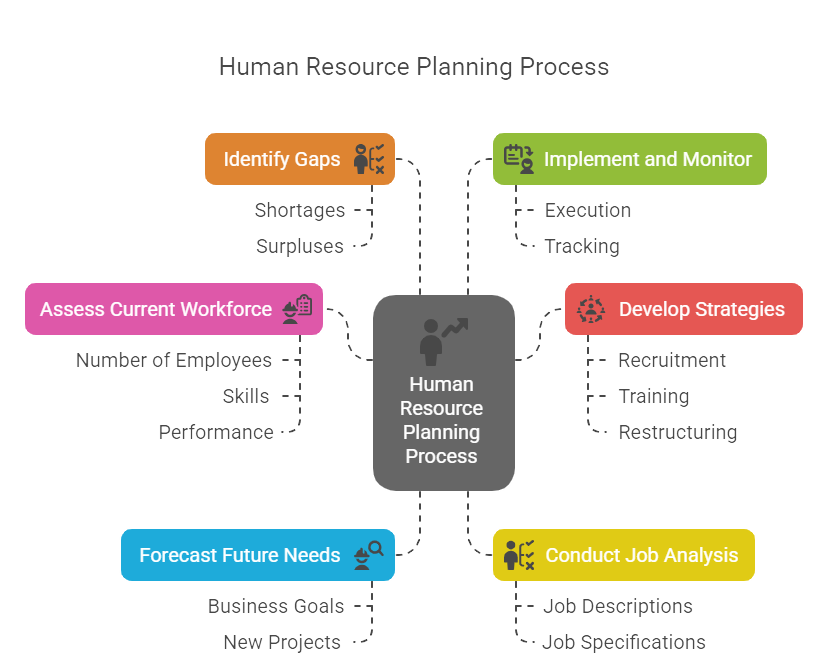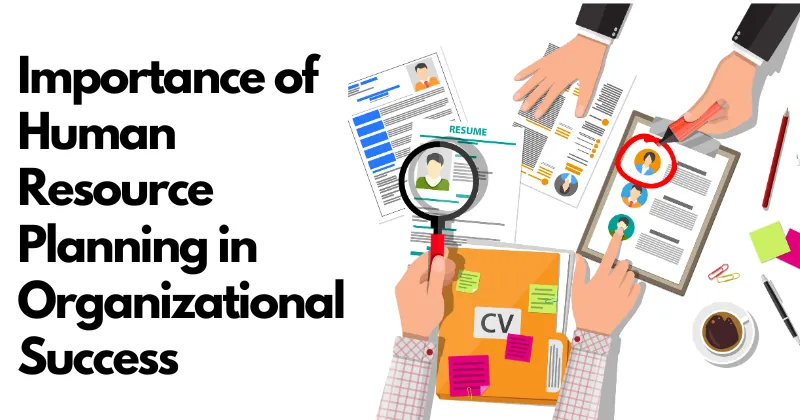The importance of human resource planning cannot be overstated for BBA students studying Human Resource Management. It’s a critical process that ensures organizations have the right people, with the right skills, at the right time to achieve their goals. As part of your BBA syllabus at Maharaja Ganga Singh University, understanding human resource planning (HRP) is essential for mastering HR concepts and preparing for real-world business challenges. This article explains why HRP matters, its benefits, steps, and real-world examples in simple language, perfect for college students.
What is Human Resource Planning?
Human resource planning is the process of forecasting an organization’s future workforce needs and creating strategies to meet them. It involves analyzing current employee skills, predicting future requirements, and ensuring the organization is prepared to handle growth, challenges, or changes. According to Module 2 of the BBA syllabus, HRP includes job analysis, job description, and job specification, which are foundational for effective workforce management.
In 2023, a SHRM survey found that 68% of organizations with structured HRP reported better employee retention and productivity. This shows why HRP is a must-learn topic for BBA students aiming for HR careers.
Why is Human Resource Planning Important?
The importance of human resource planning lies in its ability to align an organization’s workforce with its strategic goals. Without proper planning, companies may face skill shortages, high turnover, or inefficiencies. Let’s explore the key reasons why HRP is crucial, with examples to make it relatable.
1. Ensures the Right Talent at the Right Time
HRP helps organizations identify the number and type of employees needed to achieve their objectives. For instance, if a company plans to launch a new product, HRP ensures they have enough skilled staff, like marketing experts or engineers, ready to execute the plan.
Example: In 2024, Tata Motors used HRP to prepare for its electric vehicle (EV) expansion. By forecasting the need for EV engineers and training existing staff, they avoided hiring delays and stayed competitive in India’s growing EV market.
2. Reduces Recruitment Costs
Hiring without a plan can lead to rushed, costly recruitment. HRP allows companies to anticipate vacancies due to retirements, resignations, or growth and prepare in advance. This minimizes last-minute hiring expenses and ensures quality hires.
Table: Cost Savings Through HRP
| Scenario | Without HRP | With HRP |
|---|---|---|
| Hiring Time | 2-3 months (urgent hires) | 1-2 months (planned recruitment) |
| Cost per Hire | ₹50,000 (ads, agencies) | ₹30,000 (internal planning) |
| Employee Turnover Rate | 20% (poor fit) | 10% (better job matching) |
Data based on industry averages (2023-2024).
3. Improves Employee Retention
The importance of human resource planning also extends to keeping employees happy and engaged. By understanding workforce needs, HR can offer training, promotions, or career development opportunities, reducing turnover.
Example: Infosys, a leading IT firm, uses HRP to identify skill gaps and provide upskilling programs. In 2023, their retention rate improved by 15% after implementing targeted training based on HRP insights, as reported by Economic Times.
4. Supports Organizational Growth
HRP aligns workforce capabilities with business expansion plans. Whether a company is entering new markets or adopting new technologies, HRP ensures employees are ready to support these changes.
Example: In 2024, Reliance Jio used HRP to hire and train 5,000+ employees for its 5G rollout across India. By planning ahead, they ensured a smooth launch, avoiding staffing shortages.
5. Enhances Productivity and Efficiency
When employees have the right skills and roles, productivity soars. HRP involves job analysis (part of the BBA syllabus), which defines clear job roles and responsibilities, reducing confusion and overlap.
Table: Impact of HRP on Productivity
| Metric | Without HRP | With HRP |
|---|---|---|
| Employee Productivity | 70% (role ambiguity) | 90% (clear roles) |
| Project Delays | 30% of projects | 10% of projects |
| Skill Gaps | 25% of workforce | 5% of workforce |
Based on 2024 industry trends.
6. Prepares for Unexpected Challenges
HRP helps organizations stay resilient during crises, like economic downturns or pandemics. By forecasting potential risks, HR can create contingency plans, such as cross-training employees or building a talent pipeline.
Example: During the 2020 COVID-19 pandemic, HCL Technologies used HRP to shift 90% of its workforce to remote work within weeks. Their proactive planning minimized disruptions, as noted in Forbes.
Steps in Human Resource Planning
To understand the archive importance of human resource planning, let’s break down the process into simple steps, as outlined in the BBA syllabus (Module 2):
- Assess Current Workforce: Evaluate the number, skills, and performance of existing employees. For example, a company might find it has 50 engineers but only 10 with AI expertise.
- Forecast Future Needs: Predict workforce requirements based on business goals, such as hiring 20 more AI engineers for a new project.
- Conduct Job Analysis: Create job descriptions (tasks) and specifications (qualifications) to define roles clearly.
- Identify Gaps: Compare current skills with future needs to spot shortages or surpluses.
- Develop Strategies: Plan recruitment, training, or restructuring to bridge gaps. For instance, train existing staff or hire externally.
- Implement and Monitor: Execute the plan and track progress, adjusting as needed.

These steps are practical and often tested in BBA exams, making them essential for students to master.
Challenges in Human Resource Planning
While the importance of human resource planning is clear, it’s not without challenges. BBA students should be aware of these to understand real-world applications:
- Uncertain Business Environment: Economic changes or market shifts can disrupt forecasts. For example, a sudden recession may reduce hiring needs.
- Data Accuracy: Poor data on employee skills or turnover can lead to faulty plans.
- Resistance to Change: Employees may resist new roles or training, slowing down HRP implementation.
- Cost Constraints: Small businesses may struggle to fund extensive HRP processes.
Despite these challenges, effective HRP can overcome obstacles with careful planning and flexibility.
Real-World Applications for BBA Students
As a BBA student, understanding the importance of human resource planning prepares you for internships and projects like the Internship Project Report (BBA5.5DCCP52). Here’s how you can apply HRP knowledge:
- Internship Projects: If your internship involves HR, you might analyze a company’s workforce needs or create a job description. Use HRP steps to structure your project report.
- Case Studies: In exams, you may get case studies on companies facing staffing issues. Apply HRP concepts to suggest solutions.
- Career Preparation: Knowledge of HRP makes you attractive to employers in HR roles, as companies value candidates who understand workforce planning.
Check our detailed guide on HR Project Topics For BBA Students
Tips to Excel in Human Resource Planning for BBA Exams
To score well in your Human Resource Management course, keep these tips in mind:
- Understand Key Terms: Memorize definitions like job analysis, job description, and HRP steps.
- Use Examples: Refer to real companies like Tata or Infosys in answers to show practical understanding.
- Practice Diagrams: Draw flowcharts of the HRP process for better marks in descriptive questions.
- Stay Updated: Read HR trends on sites like HR Dive to add current insights to your answers.
- Prepare for Vivas: Be ready to explain why HRP matters, using syllabus concepts like organizational structures (Module 2).
Conclusion
The importance of human resource planning lies in its ability to drive organizational success by ensuring the right talent, reducing costs, boosting retention, and preparing for growth or crises. For BBA students, mastering HRP is not just about passing exams—it’s about gaining skills for real-world HR roles. By understanding the steps, benefits, and challenges of HRP, you’ll be well-equipped for your Human Resource Management course and future career. Use this knowledge in your internship projects, case studies, and job applications to stand out.
👨💼 Author: BBAProject Editorial Team
✍️ The BBAProject Editorial Team comprises business graduates and educators dedicated to creating practical, syllabus-based learning resources for BBA students.
⚠️ Please Note: Articles published on BBAProject.in are well-researched and regularly updated. However, students are advised to verify data, statistics, or references before using them for academic submissions.

